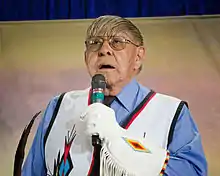Earl Old Person
Earl Old Person (born April 13, 1929), Blackfeet name - Cold Wind (Stu Sapoo) and Cold Wind or Charging Home (Ahka Pa Ka Pee[1]), is an American Indian political leader and the chief of the Blackfeet tribe in Montana, United States.[2] Old Person became a member of the Blackfeet Tribal Business Council in 1954 and served as tribal chairman from 1964 to 2008.[2][3] He has also served as president of the National Congress of American Indians.[4]

In July 1978, Old Person was appointed honorary lifetime Chief of the Blackfeet Nation. Old Person holds an honorary doctorate from the University of Montana. In 1998, he was awarded the Jeannette Rankin Civil Liberties Award by the American Civil Liberties Union of Montana.[5] In 2007, he was inducted into the Montana Indian Hall of Fame.[6]
It is important to note that in our Indian language the only translation for termination is to "wipe out" or "kill off"... how can we plan our future when the Indian Bureau threatens to wipe us out as a race? It is like trying to cook a meal in your tipi when someone is standing outside trying to burn the tipi down.
— Earl Old Person, speaking for the National Congress of American Indians against US plans for termination of treaty obligations in 1960[7]
References
- Kyiyo: Native American Student Association
- William L. Bryan, Montana's Indians: yesterday and today, Farcountry Press, 1996, p.66 ISBN 1-56037-064-5
- "Longtime Blackfoot chair Earl Old Person ousted in elections", News From Indian Country, ICC, Inc, July 2008
- Tribune Staff. "125 Montana Newsmakers: Earl Old Person". Great Falls Tribune. Retrieved August 27, 2011.
- Earl Old Person Archived 2008-10-11 at the Wayback Machine, The Institute for Tribal Government, Portland State University, retrieved 12-05-2009
- "Earl Old Person inducted into Montana Indian Hall of Fame", Golden Triangle News, July 3, 2007
- Angie Debo, A History of the Indians of the United States, Norman: University of Oklahoma Press, 1977, p.371